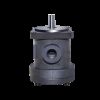Group Info
Learn About Variable Displacement Oil Pumps
The variable displacement oil pump controls the working intensity of the pump by matching the pressure and volume with the conditions. These conditions can include engine temperature, load and engine speed.
Another advantage of controlling oil pressure and oil volume is heat management. By adjusting the oil flow rate, the heat transfer in the cylinder head and piston can be optimized. On turbocharged engines, oil flow control can reduce the formation of carbon deposits.
Angle of the diagnostic component
The variable displacement
oil pump system is more than just a pump. The six components play an active role
in calculating the performance of the pump.
oil
Modern vehicles know their oil, or at least the oil
specified by the manufacturer. The vehicle knows what the viscosity and flow
characteristics should be because this information has been programmed into the
ECM. They know that someone installs a 10W-30 when they really need a 5W-20
because it will affect the pump performance.
Wrong oil will cause code errors because ECM knows the oil pressure at a given engine speed and coolant temperature. If the numbers do not match, it will set a code and put the engine in power saving mode.
Pump type
Almost all variable displacement oil pump
applications are mounted on the crankshaft. This arrangement eliminates the need
for intermediate shafts that may fail.
The variable displacement pump is a "rotor" design. The gear rotor pump has a cycloid gear, which can achieve smooth operation, low noise and excellent suction. The eccentrically arranged drive gear drives the eccentric and eccentric external ring gear. The result is that the cavity in the pump is compressed and enlarged to produce suction and feed effects.
The inner rotor is located on the crankshaft and drives the outer rotor. Since the inner rotor and the outer rotor have different rotating shafts, more space will be created on the suction side due to the rotational movement. The oil is sucked in and delivered to the pressure side. On the pressure side, the space between the gear teeth becomes smaller again, and oil is forced into the oil circuit under pressure.
The variable displacement oil pump changes the rotation axis of the external gear. For this reason, the gears of the inner rotor are replaced with variable-length blades. The external gear pivots around an axis; opposite the pivot axis is an electronic actuator. In the mechanical version, a spring replaces the actuator, and the other side of the housing has oil or a piston that pushes against the spring to adjust the pressure.
Actuator
Most variable displacement oil pumps use solenoids
to change the axis and eccentricity of the pump casing, and the position is
determined by the ECM. Changing the geometry of the housing will change the
pressure and volume of the pump. Most actuators use pulse width modulation
signals to control the position of the actuator, and some scanning tools can
display the PID of the actuator position.
Oil pressure sensor
The oil pressure sensor on most variable
displacement oil pump systems is located in the galley between the main bearing
and the nose. The pressure sensor measures the total pressure in the system, not
just the pressure produced by the pump. If problems such as restrictions or
internal leaks occur, the sensor will display erroneous readings, so these
problems should be resolved before replacing the pump.
Engine oil temperature
On most vehicles, the oil
temperature is calculated using various sensor inputs rather than direct
sensors. The calculation of engine oil temperature is a range of values. A low
value indicates that the oil temperature is low, and a high value indicates that
the oil temperature is high. On vehicles equipped with variable displacement oil
pumps, the oil temperature is critical to calculating the position of the
actuator during a cold start.
ECM
ECM will look at data, including engine coolant
temperature, engine load, calculated oil temperature, and other monitors to
determine the position of the oil pump actuator and the oil pressure. If the
system detects overheating or a problem with one or more inputs, it may put the
system into a low-power mode to prevent damage.
Years ago, diagnosing a low or high oil pressure problem was simple-it was a worn out component or a damaged pressure regulator. With the variable displacement oil pump, the situation has changed. You must look at the oil pan of the entire system to determine the problem and solution.
The Oil
Pumps works by circulating oil under pressure to the rotating bearings,
sliding pistons and camshafts of the engine. Large-capacity fluid bearings can
be used to help cool the engine. Zhejiang Yongling Hydraulic Machine Co , Ltd .
is a professional manufacturer and supplier of pump cores for oil pumps and Vane Pumps . Follow us for more
product details and technical information: https://www.china-vanepump.com/product/sqp-series-vane-pumps-with-lower-noise/sqp1-vane-oil-pump-with- lower-noise.html
- Created: Aug 9 '20
- Admin: Cassidyvanepump
Users
Newsfeed
- No items

